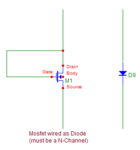shemo
Advanced Member level 4
NMOS is NPN (Drain Gate Source)
Diode connected NMOS is Gate tied to the Drain. as indicated by the picture

I have on the direction of the diode.
1)since Gate is P and Drain is N, therefore the positive of the Diode should be on the Gate side? So, the picture with the diode should be reversed?
2)why it sometimes called diode load, the diode has little resistance, why it's being used as load.
3)what difference is enhancement versus depletion on the transistor?
Diode connected NMOS is Gate tied to the Drain. as indicated by the picture

I have on the direction of the diode.
1)since Gate is P and Drain is N, therefore the positive of the Diode should be on the Gate side? So, the picture with the diode should be reversed?
2)why it sometimes called diode load, the diode has little resistance, why it's being used as load.
3)what difference is enhancement versus depletion on the transistor?